Metal Crafts
Metal Crafts (ancient) reflect human skill and ingenuity rather than the use of power devices. In the past, metal crafts were resorted to for making objects for rulers and nobles as well as for their subjects, for both religious and secular purposes. Today objects are made for wealthy citizens, the middle class, and humble households. While religious and secular demands remain constant, objects have become even more disparate in use and form to meet diverse needs.
Metal Crafts Metallurgy began in Bengal as early as 1500 BC in the Chalcolithic Age. The full-fledged use of iron is noticed in about 1000 BC. Copper and its alloy and iron were the most used metals, although silver and gold were also used on a limited scale.
Copper and its alloys Copper has been used from the early Chalcolithic period. The use of alloy has also been traced from objects attributed to the late Chalcolithic period. Copper objects were manufactured by casting and by subsequent forging practices. Alloying with tin was known but the knowledge relating to its proper composition was not adequate. The objects mostly found are bangles, beads, earrings, finger rings, fishhooks etc. The analysed bronze specimens with more or less 9-11% tin belonging to this period was found in Bahiri, Bharatpur, dihar, mangalkot and pandu rajar dhibi. In the early historic period, the use of high tin bronze, popularly known as kansa was noted.

This alloy, containing around 22.5% tin, is known as beta-bronze. This bronze appears golden in colour after it has been quenched and polished. High tin bronze (kansa) vessels of Bengal origin have been discovered at Ban-Don-Ta-Pet, Thailand. The water bowls made of this material were brittle but its golden appearance was highly esteemed in society. High tin bronze mirrors have also been found at chandraketugarh and mahasthan. cast copper coins were common, but their use began in the Maurya period. Massive use of brass began in the Pala-Sena days. It can therefore be said that the speciality of Bengal is the manufacturing of high tin bronzes.

Iron was initiated in the late Chalcolithic period in Bengal. In the early historic period, iron was produced in Bengal on a large scale. There was an all-round growth in trade and commerce in this period. Evidence of early iron-making were found in Bahiri, Hatikra, Mangalkot, Pandu Rajar Dhibi etc. Steel is the addition of carbon in iron, the process is also known as Carburisation. It was known earlier but specific use of quenching and tempering can be traced back to third century BC from Pandu Rajar Dhibi. The smiths hardened the carburised iron by heating them till they became red-hot and then quickly quenching them in water. To make the hardened iron less brittle, they reheated the quenched one to an intermediate temperature; this process is known as tempering. The technique was followed only in making tools, since their manufacture demanded a sharp cutting edge. The sharpness was achieved later by polishing them with stone blocks.
The process of making, shaping, and treating iron objects was perfected in the period under review. The use of different types of iron indicates the awareness blacksmiths had of the characteristics of the metal. The wide varieties in tool types indicate the responsiveness of the smiths to the different needs.
Everyday use of metals Excavations at Mangalkot at the Chalcolithic level, yielded a fishhook, a ring and some bangles; at the Iron Age level (period III) bangles, rings, beads, bowls, etc and at the early historic level (period IV) copper in abundance. Copper needle; bowl’s fragment, snake shaped bangle etc along with large number of cast copper coins have also been found.

Ornaments made of copper or its alloy were popular in both North-Indian Black pottery (NBP) and in the early historic period. But the limited find of such ornaments suggest their restricted use in society. The ornaments are amulets, beads, bangles, ear ornaments, rings, bangles, hairpin, etc.
Copper objects Copper or copper alloyed objects are basically of five types: 1) ornaments, 2) utensils and household goods, 3) implements, 4) copper hoard objects and 5) bronze images. In the early historic period, copper objects like amulets, awls, collyrium stick, and rings were recovered from Bangarh. From Chandraketugarh and Harinarayanpur scarabs, hairpin etc were recovered in surface exploration. In the historic period mirrors made of high tin bronze, needle, bowls, dish, and other objects were used.
Use of small copper tools, such as nail-pares and fishhooks persisted in the early historic period, but these were gradually replaced by iron. Copper hoards are perhaps the most enigmatic of prehistoric metallic objects. Almost all these copper hoard objects were chance finds. In fact, the origin and the subsequent development of copper hoard objects have not been satisfactorily explained so far. These copper objects were found in Southwest Bengal, from sites such as Kushadwip, and Parihati etc.
From the Gupta period onwards thousands of bronze images or icons were made in Bengal. It was in the Pala period that this industry reached its zenith. Copper plates, used for recording land transactions, have been discovered all over Bengal.
Iron objects Immense use of iron is noted from material remains. The most important agricultural tool discovered is the sickle. A remarkable pottery plaque recovered from Chandraketugarh represents a scene of a former cutting paddy with the help of a large sickle. This indicates the popularity of this instrument in the early historic period. Evidence of the use of sickles is to be also found in Pandu Rajar Dhibi, Hatikra and Mangalkot.
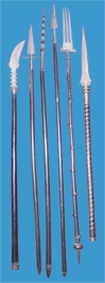
The last site has yielded a hoe as well. Spearheads and arrowheads have also been found in most of the sites in Bengal. In the wari-bateshwar area, spearheads and iron ingots were found. Arrowheads with medial ridges and hollow tangs and a broken sword have been recovered from Pandu Rajar Dhibi. Other iron objects used in early historic period were points, knives, swords, nails, spikes, awls, chisels and daggers. These have also been discovered in mainamati. Iron manufacturing can be credited to the tribals of this region. The tribal iron technology was the prime motivational factor behind the spread of the craft throughout Eastern India.
Gold and silver The scarcity of these two noble metals indicates that at the NBP level they were perhaps not present. But in the early historic period use of both these metals were used in the making of small ornaments and coins. In addition to punch-marked coins made of silver, the early historic level of Bangarh has yielded gold amulets and pendants. A silver rod has also been recovered from this site which was probably used as a raw material for ornament. Through surface exploration at Chandraketugarh silver vessels have also been found. Terracotta mould for gold smiths, along with gold pellets and beads have been recovered from Pandu Rajar Dhibi. Excavations at Mainamati-Lalmai areas of Bangladesh have yielded large number of gold, silver and bronze ornaments.
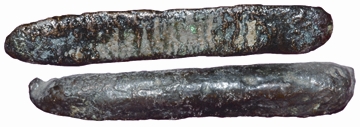
Silver trade In Bengal evidence of use of silver is scanty. Pundranagar was an important trade centre of Bengal from Maurya period. Silver was imported into Bengal from North Burma and Yunan. After the fall of the Guptas, samatata flourished and was involved in silver trade with Arakan. harikela coins of Bangladesh indicate the use of imported silver. [Pranab K Chattopadhyay]
Metal Crafts (Modern) the metal crafts in Bangladesh fall into six major categories: ironwork, bell-metalwork, brasswork, goldwork, silverwork, and ornamental work. The metalworkers who are involved in ironwork are known as kamars (blacksmiths); those who do either bell-metalwork or brasswork are generally called kansyakars or kansaris (bell-metalsmiths and brass-smiths); svarnakars (goldsmiths and silversmiths) are those who make objects in gold and silver; and those who do ornamental work in any metal are termed either nakxi karigars (designers) or khudaikars (chasers, engravers, and embossers).
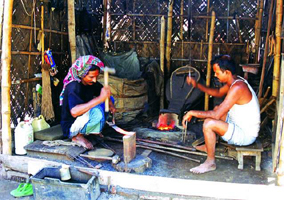
Gold is rarely used to make anything other than jewelry and medals. Silverwork, however, includes the production of jewelry, silver plate, and filigree. Dhaka's gold-and silversmiths were once very famous for gold and silver filigree. It died out in the early twentieth century. About ten years ago silver filigree was revived, though the old splendor is yet to be achieved. It is attaining a level of good workmanship.
Metal crafts are based on three traditional methods of metalworking: (1) pitaikaj, that is, the hammering or beating method, (2) dhalaikaj, that is, the casting method, and (3) chadarkaj, that is, the brazing method. Pitaikaj, dhalaikaj, and chadarkaj are called smithing, casting, and brazing respectively. Pitaikaj is based on forging metal, dhalaikaj on solidifying molten metal, and chadarkaj on battered scraps or pre-fabricated sheet metal available ready-made.
The hammering or beating method is generally the technique pursued by all metal craftsmen. There are five major branches of smithing: (1) blacksmithing, (2) bell-metalsmithing, (3) brass-smithing, (4) silversmithing, and (5) goldsmithing. Silversmiths and goldsmiths use the techniques of decoration in addition to the hammering or beating method. The hammering or beating method is applied mostly for fabricating domestic utensils. Metal is also melted into a mass for casting by pouring molten metal into a planned mold and letting it cool and harden.
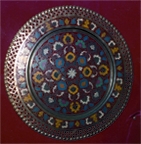
There are two kinds of casting: solid casting and hollow casting. When the entire cavity is filled with molten metal, it solidifies into a solid metal object. A core is necessary if the cast metal object is to contain a hollow space. There are three methods of casting: (1) open mold casting; (2) the cire-perdue or lost-wax casting; and (3) sand casting. Open mould casting using double clay molds is widely practiced in Dhamrai. Wax casting is widely prevalent in Dhamrai and at Lalbagh in Dhaka City. Sand casting is an invention of the eighteenth century. One important feature of sand casting is that molds are either temporary or permanent. In an atelier at Lalbagh in Dhaka City, dark soil rather than sand is used in the same manner as sand casting. This is an innovation in Bangladesh. The casting method is generally used for making images, lamps and toys.
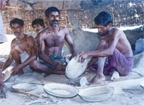
Seven things are essential to smithing and casting: (1) ingots or metals available for recycling, (2) fuel, (3) furnaces, (4) blast air, (5) crucibles, (6) a trough of water, and (7) tools. An ingot is a mass of metal, such as copper, tin, silver, or gold, cast into a block or bar (usually oblong or brick-shaped) to be recast, rolled, or forged at a later time. Metals available for recycling come from three major sources: household scraps (discarded wares collected from houses), industrial scraps, and scraps obtained from abandoned ships when they are dismantled.
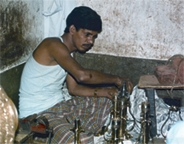
The tools for the hearth or the forge include pokers and shovels. The poker is a metal rod for stirring a fire. The shovel is a tool with a broad blade or scoop attached to a handle, used to lift and throw loose matter. The principal tools in smithing are anvils, hammers, stakes, scrappers or chisels, and a selection of tongs with variously shaped jaws. There are also various shafted tools, which the metalworker uses to bring the metal to the desired shape. These are used for smoothing or flattening its surface.
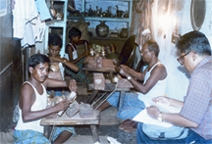
The methods or techniques that are currently and generally used in decorative metalwork are (1) chasing, (2) engraving, (3) repousse, (4) embossing, (5) etching, (6) incising, (7) inlaying, (8) pierced work, and (9) filigree.
Metal Crafts reflect human skill and ingenuity rather than the use of power devices, manifest the tastes and demands of diverse social and economic classes. In the past, metal crafts were resorted to for making objects for rulers and nobles as well as for their subjects, for both religious and secular purposes. Today objects are made for wealthy citizens, the middle class, and humble households. While religious and secular demands remain constant, objects have become even more disparate in use and form to meet diverse needs. [Firoz Mahmud]
